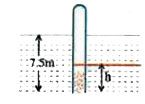A flask contains 100 c.c of a liquid at 10∘C. When it is heated to 110∘C increase in volume of the liquid appears to be 2 c.c. Find the coefficient of real expansion of the liquid.
(α of flask is 11×10−6/∘C).Solution in Telugu
Initial volume of the liquid (v1)=100c.c
Initial temperature (t1)=10∘C, Final temperature (t2)=110∘C
Apparent increase in volume =(v2−v1)=2c.c, Coefficient of apparent expancion
γa=v2−vtv1(t2−t1)=2100(11−10)=2×10−4/∘C
Coefficient of cubical expansion of the flask 220−6200.20−92200−29=1302005=3×11×10−6=33×10−5/∘C
Coefficient of real expansion of the liquid, γR=γa+γ=2×10−4+33×10−6=2×10−4+0.33+10−4
∴γR=2.33×10−4/∘C
Topper's Solved these Questions
- BOOK - AAKASH SERIESCHAPTER - EXPANSION OF LIQUIDS EXERCISE - TEST YOUR SELF5videos
EXPANSION OF LIQUIDS
- BOOK - AAKASH SERIESCHAPTER - EXPANSION OF LIQUIDS EXERCISE - VERY SHORY ANSWER TYPE QUESTIONS15videos
EXPANSION OF LIQUIDS
- BOOK - AAKASH SERIESCHAPTER - EXPANSION OF GASESEXERCISE - QUESTIONS FOR DESCRIPTIVE ANSWERS4videos
EXPANSION OF GASES
- BOOK - AAKASH SERIESCHAPTER - EXPANSION OF SOLIDS EXERCISE - Questions for Descriptive Answers5videos
EXPANSION OF SOLIDS
Similar Questions
Is the real coefficient of expansion of water between 0∘Cand4∘C positive or negative? Explain.
03:27View SolutionWhy the expansions of the liquids is greater than the expansion of the solids ?
06:29View SolutionA thin uniform tube of length 9 m closed at one end is immersed in water to a depth of 7.5 m. Find the height h to which water rises in the tube. Ignore any temperature change and take atmosphere pressure as 10 mg water column.
 02:13View Solution
02:13View SolutionThe length of an iron rod is measured by a brass scale. When both of them are at 20∘C, the length is 80 cm. What is the length of the rod at 100∘C as measured by the scale at 100∘C? The coefficient of linear expansion of brass and iron are 24×10−6(C∘)−1and18×10−6(C∘)−1 respectively.
01:53View SolutionA flask cotaines 100c.c of a liquid at 10^(@)C . When it is heated to 110^(0)C increase in volume of the liquid appers to be 2 c.c. Find the coefficient of real expansion of the liquid. ( alpha of flask is 11 xx 10^(-6 //@)C )
View SolutionA non-conducting body floats in a liquid at 20^(@)C . with 2//3 of its volume immersed in the liquid When liquid temperature is increased to 100^(@)C, 3//4 of body volume is immersed in the liquid. Then the coefficient of real expansion of the liquid is... (neglecting the expansion of container of the liquid)
02:07View SolutionA non-conductiong body floats in a liquid at 25^(@)C with 1//3 of its volume immersed in the liquid. When liquid temperature is increased to 105^(@)C, 1//2 of body's volume is immersed is the liquid. Then, find the coefficient of real expansion of the liqquid (neglecting the expansion of container of the liquid) .
02:58View SolutionA non-conducting body floats in a liquid at 20∘C with 23 of its volume immersed in the liquid. when liquid temperature increased to100∘c, 34 of body's volume 3. 4 is immersed in the liquid. Then the coefficient of real expansion of the liquid is (neglecting the expansion of container of the liquid)
03:31View Solutionα3 দৈর্ঘ্য প্রসারণ গুনাঙ্কের কোনো পাত্রে α আয়তন প্রসারণ গুনাঙ্কের কোনো তরলকে উত্তপ্ত করলে, তরলতল
03:42View SolutionThe volume of a liquid at 10^(@)C is 50 c.c. Find its volume at 100^(@)C ? ( gamma_(R) of liquid is 7xx10^(-4)//""^(@)C ).
View SolutionA flask contains 100 c.c of a liquid at 10^(@)C . When it is heated to 110^(@)C increase in volume of the liquid appears to be 2 c.c. Find the coefficient of real expansion of the liquid. ( alpha of flask is 11xx10^(-6)//""^(@)C ).
View SolutionDensity of a substance at 0∘C is 10.6 gm/c.c and at 100∘C is 10 gm/c.c. coefficient of linear expansion of solid is
View SolutionDensities of a liquid at 30∘Cand80∘C are 0.6gm/c.c and 0.54 gm/c.c. The coefficient of real expansion of liquid is
05:12View SolutionIf 13.6 gm/c.c and 13.52 g/c.e are the densities of a liquid at 10∘Cand50∘C, find the coefficient of real expansion of the liquid
03:42View SolutionA bottle contains 82 gm of liquid of 10∘C. When it is heated to 35∘C, 2 gm of liquid is expelled. Calculate the apparent coefficient of expansion of liquid.
View Solution

